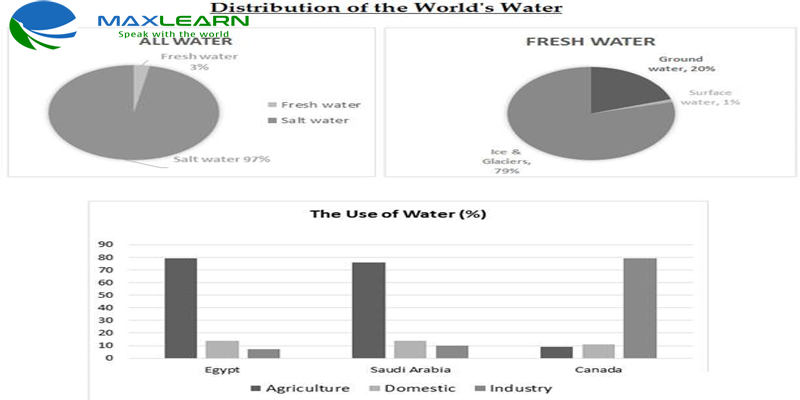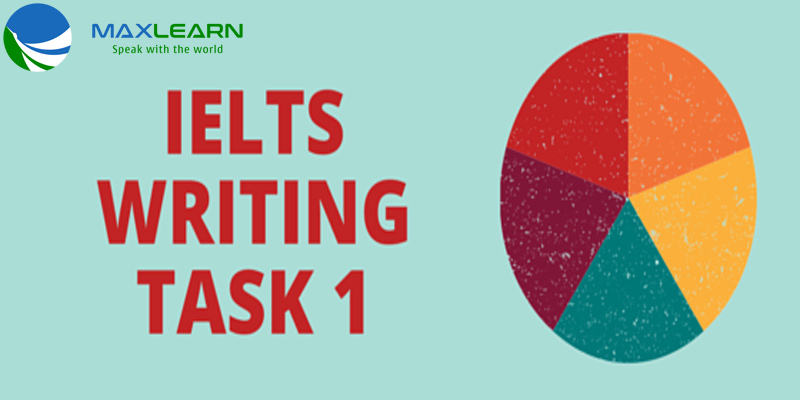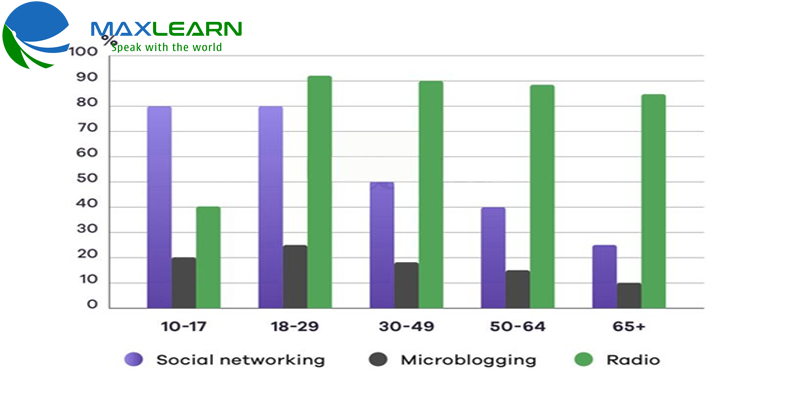Mô tả số liệu IELTS WRITING TASK 1
Hôm nay Maxlearn sẽ hướng dẫn các bạn một số cách miêu tả số liệu trong IELTS writing task 1 để các bạn có thể làm phong phú thêm bài viết của mình nhé.

1. Cách liệt kê (list) số liệu trong câu văn
1.1. Tổng quan
- Sẽ có dấu , trước các giới từ with và at
- Đứng một mình giới từ + số liệu để mô tả số liệu & không phụ thuộc vào danh từ phía trước danh từ như mục dưới (mục số 2)
Có 3 cách để liệt kê số liệu trong Writing Task 1
- Dùng từ AT
- Dùng từ WITH
- Dùng (....)
Ví dụ:
- Likewise, California has experienced the dominant use of water for residential and industrial reasons, with 39% and 33% respectively.
- Likewise, California has experienced the dominant use of water for residential and industrial reasons, AT 39% and 33% respectively.
- Likewise, California has experienced the dominant use of water for residential and industrial reasons, ( 39% and 33% respectively )
1.2. Cách dùng "at/with" liệt kê số liệu
Khi liệt kê số liệu at & with thay thế cho nhau được
Ví dụ:
- Regarding the pie charts, the percentage for spending on meat and fish was highest of all categories in 2010, at 29%, but three years later experienced a drop to 23%.
- Water consumption per person in Brazil, at 359m³, was much higher than that in the Congo, at only 8m³, and this could be explained by the fact that Brazil had 265 times more irrigated land.
- This is followed by over-cultivation, with 28% of the land being deteriorated due to this cause The figures for industrial consumption are the same in San Diego and the rest of the world, with 23% of water being used.
1.3. Cách dùng (....) liệt kê số liệu
Ví dụ: Theft, of which there are 94 cases per 10 000 people, is slightly more common than violence (65 cases).
Lưu ý:
- Nếu mình dùng Theft, of which there are 94 cases per 10 000 people, is slightly more common than violence (65) vẫn đúng.
- Tức là chỗ số liệu 65 không cần đơn vị cases vẫn có thể chấp nhận được vì đã có dùng trước đó đã khá rõ ràng 94 cases thì người đọc có thể tự suy (65) thành (65 cases) được nhưng nếu phía trước, cụ thể ở đây là 94 chưa nhắc gì cả thì dùng 65 hay 94 không có đơn vị cases sẽ làm câu khó hiểu.
- Tuy nhiên , nên viết đầy đủ số liệu ra thì sẽ dễ hiểu và chắc chắn không bao giờ sai
- Theft, which accounts for 94 cases per 10 000 people, is just under four times more common than other crimes, excluding violence (25 cases)
- Not including theft, there are nearly three times more incidences of violence (65 cases per 10 000 people) than of other crimes (25 cases).
- Full-time employment (56,18%) is considerably more common than part-time (19,24%) and casual employment (24,58%).
- About twice as many people are employed in full-time work (just over 50%) than in casual work, which accounts for about 25%.
- Firstly, in terms of production figures, South America is the highest (44%), followed by Africa, Asia and Central America (19%, 18% and 17% respectively), leaving Oceania far behind (2%).
- Moving on to the pie chart, the largest percentage of students ENROLLING FOR/in evening courses went on those aged 50 or over (42%), followed by the figures for students in 40-49 and 30-39 age groups, with 26% and 16% respectively.
- However, in this state, a more higher proportion of water used for agriculture compared to San Diego county is recorded (28%)
2. Các giới từ thường đi với số liệu
Lưu ý: Các giới từ sẽ phụ thuộc vào danh từ phía trước & không phải như mục 1 phía trên là đứng một mình giới từ + số liệu nhé
2.1. At
Giải thích: Sở dĩ đi với at được là vì bản thân động từ stand, remain stable và peek đi với at nhé
Lưu ý: Stand at + số liệu: đứng tại mức (vào 1 mốc cố định)
Ví dụ:
- The crime rate stood at 5% in 2000. ( Tỉ lệ tội phạm đứng ở mức 5% vào năm 2000)
- remain stable/remained the same at + số liệu: giữ nguyên tại mức
Ví dụ:
- The figure for rice export in Vietnam remained stable at $15 million in 2015.
- peak at + số liệu: đạt mức cao nhất là bao nhiêu
Ví dụ: The amount of electricity produced peaked at 10,000 units in 2000.
2.2. To - By - of
2.2.1. To - By - Of thường đi với các danh từ tăng trưởng như increase / rise ....
(verb) increase/decrease to + số liệu: tăng đến/giảm xuống mức
Ví dụ:
- The number of students increased to 10,000 after 2 years. ( Số lượng học sinh tăng đến mức 10,000 sau 2 năm)
- (noun) an increase/decrease to + số liệu: một sự tăng đến/giảm xuống mức
Ví dụ:
- There was an increase to 10,000 in the number of students after 2 years.
- (verb) increase/decrease by + số liệu: tăng thêm/giảm đi bao nhiêu
Ví dụ:
- The number of students increased by 2,000 after 2 years
- (noun) an increase/decrease of + số liệu: một sự tăng thêm/giảm đi bao nhiêu
Ví dụ: There was an increase of 2,000 in the number of students after 2 years.
2.2.2. ...point + of
Lưu ý: reach a peak/reach the highest point of + số liệu: đạt lên mức cao nhất là bao nhiêu
Ví dụ: The amount of electricity produced reached a peak of 10,000 units in 2000. ( Lượng điện được sản xuất đạt mức cao nhất là 10,000 đơn vị vào năm 2000)
hit a low/hit the lowest point of + số liệu: chạm mức thấp nhất là bao nhiêu
Ví dụ: The amount of electricity produced hit the lowest point of 5,000 units in 1980. Lượng điện được sản xuất chạm mức thấp nhất là 5,000 đơn vị vào năm 1980)
2.3. around/ between… and…
Lưu ý: fluctuate/a fluctuation around + số liệu: biến động trong khoảng
Ví dụ: The unemployment rate of Vietnam fluctuated around 10% from 2007 to 2010. (Tỉ lệ thất nghiệp ở Việt Nam biến động trong khoảng 10% từ 2007 đến 2010)
fluctuate/a fluctuation between… and….: biến động ở mức giữa…. và….
Ví dụ: The unemployment rate of Vietnam fluctuated between 8% and 12% from 2007 to 2010. (Tỉ lệ thất nghiệp ở Việt Nam biến động trong khoảng từ 8 đến 12% từ 2007 đến 2010)
2.4. From..to...
Lưu ý: From...to... thể hiện sự biến đổi của số liệu (được dùng khi mô tả biểu đồ có yếu tố thời gian).
Ví dụ: The number of cars increased from almost 2 million in 2010 to approximately 4 million in 2012
II. CÁCH MÔ TẢ SỐ LIỆU KHÁC
1. Cách dùng "Respectively"
Lưu ý: Có nghĩa là lần lượt, dùng để tránh việc lặp đi lặp lại câu miêu tả số liệu của một nhân tố trong biểu đồ.
Ví dụ: Likewise, California has experienced the dominant use of water for residential and industrial reasons, ( 39% and 33% respectively )
2. Cách đổi phần trăm
- 50% = a half
- 33% = a third
- 25% = a quarter
- 20% = a fifth
- 10% = a tenth
- 66% = two thirds
- 75% = three quarters
- 10% = one in ten
- 20% = two in ten etc etc
- over 50% = a majority
- under 50% = a minority
- 4% = A tiny fraction.
- 24% = Almost a quarter.
- 25% = Exactly a quarter.
- 26% = Roughly one quarter.
- 32% = Nearly one-third, nearly a third.
- 49% = Around a half, just under a half.
- 50% = Exactly a half.
- 51% = Just over a half.
- 73% = Nearly three quarters.
- 77% = Approximately three quarter, more than three-quarter.
- 79% = Well over three quarter.
- 2% = A tiny portion, a very small proportion.
- 4% = An insignificant minority, an insignificant proportion.
- 16% = A small minority, a small portion.
- 70% = A large proportion.
- 72% = A significant majority, A significant proportion.
- 89% = A very large proportion.
Ví dụ:
- A small group shows to have taken interest in studying German, as well as, Spanish.
- A minority is shown to represent those studying German, Spanish and French.
- According to the Eurostat survey, a very large number choose to study English. In fact, this number is larger than putting all the other top three languages together.












